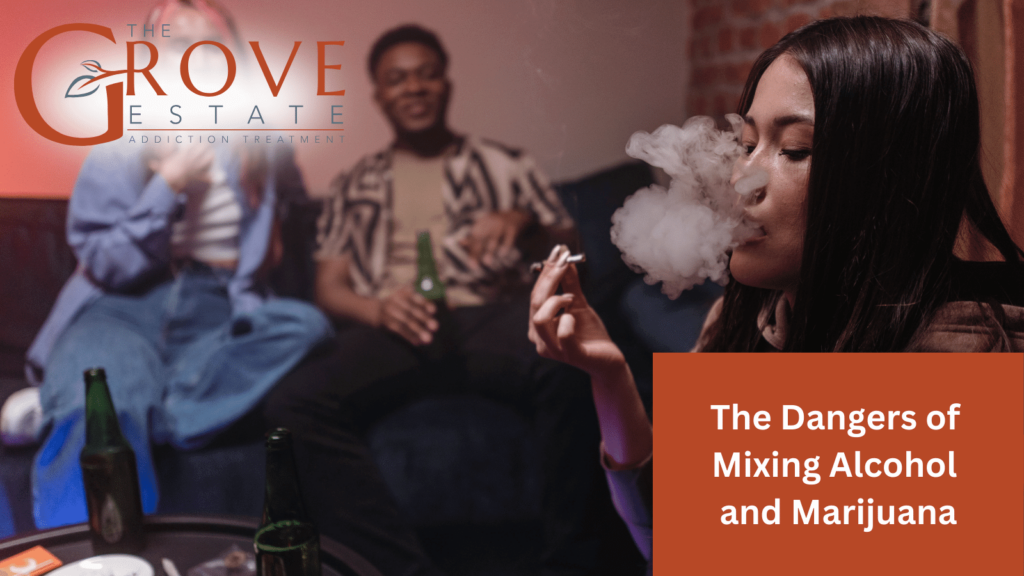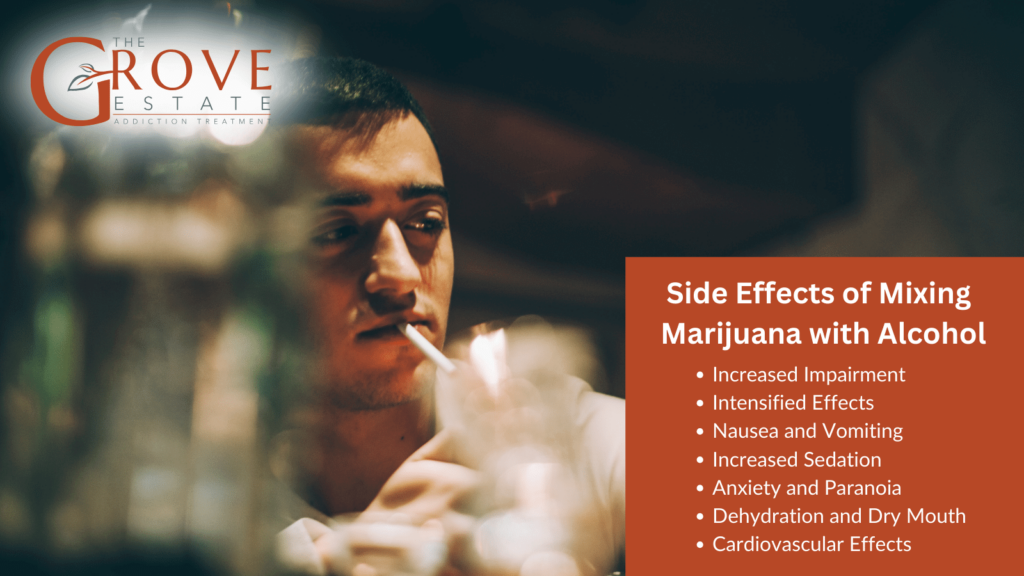The concurrent use of alcohol and marijuana represents a growing trend with significant implications for public health and safety. As two of the most widely consumed psychoactive substances globally, understanding the effects of their combined use is increasingly important. Combining the two affects users in varied ways including altered senses, mood changes, and impaired body movement.
According to the National Institute on Drug Abuse, individuals who consume alcohol are significantly more likely to use marijuana, and vice versa, suggesting a synergistic relationship in substance use patterns. This trend is particularly noticeable among young adults and college students, with research indicating that simultaneous use can lead to higher levels of intoxication and an increased risk of engaging in risky behaviors compared to the consumption of either substance alone.

What Happens in the Body When Mixing Alcohol and Marijuana?
When alcohol and marijuana are consumed together, their interaction within the body can lead to complex effects, some of which are amplified compared to when these substances are used separately. Scientifically, the interplay between alcohol and marijuana involves several physiological mechanisms that alter the body’s response to these substances.
Alcohol is absorbed through the stomach and small intestine into the bloodstream, where it then affects the central nervous system (CNS) by enhancing the inhibitory neurotransmitter GABA (gamma-aminobutyric acid) and reducing the activity of the excitatory neurotransmitter glutamate. Marijuana’s primary psychoactive component, THC (tetrahydrocannabinol), interacts with the body through the endocannabinoid system by binding to cannabinoid receptors in the brain and throughout the body.
When alcohol and marijuana are used together, alcohol can increase the absorption of THC, leading to higher plasma THC levels and a more pronounced psychoactive effect. This occurs because alcohol may cause blood vessels in the digestive system to dilate, increasing the rate of THC absorption. Both substances being metabolized in the liver can lead to competitive inhibition, affecting the rate at which each substance is broken down and eliminated from the body.

What are the Short-Term Effects of Mixing Alcohol and Marijuana?
Mixing alcohol and marijuana can lead to a range of short-term effects on the body and mind. These effects can vary widely depending on factors such as the amount consumed, the individual’s tolerance levels, and their unique physiological makeup. Here are some of the key short-term effects associated with the simultaneous use of alcohol and marijuana:
- Increased Impairment: The combination can lead to greater impairment of motor skills, coordination, and judgment than when either substance is used alone. This can significantly increase the risk of accidents, injuries, and engaging in risky behaviors.
- Intensified Effects: Alcohol can increase THC absorption in the bloodstream, potentially leading to more intense psychoactive effects of marijuana, including heightened euphoria, altered perception, and increased anxiety or paranoia in some individuals.
- Nausea and Vomiting: The interaction between alcohol and marijuana can exacerbate feelings of nausea and increase the likelihood of vomiting, especially if large amounts of both substances are consumed.
- Increased Sedation: Both alcohol and marijuana have sedative effects, and when used together, these effects can be amplified, leading to increased drowsiness and lethargy. This can impact an individual’s ability to perform tasks that require attention and coordination.
- Anxiety and Paranoia: For some individuals, the combination of alcohol and marijuana can trigger or worsen feelings of anxiety and paranoia. The interaction of these substances can lead to a more unpredictable emotional and psychological state.
- Dehydration and Dry Mouth: Both alcohol and marijuana can lead to dehydration and a sensation known as “cottonmouth,” or dry mouth. When mixed, these effects can be more pronounced, contributing to discomfort and potential dehydration.
- Cardiovascular Effects: Mixing alcohol and marijuana can lead to changes in heart rate and blood pressure. While marijuana alone can cause an increase in heart rate, adding alcohol to the mix can lead to more unpredictable cardiovascular responses.
Does the Order of Substance Use Matter?
The sequence of consuming alcohol and marijuana significantly affects their combined effects on the body and mind.
Alcohol Before Marijuana
- Intensified Effects of THC: Alcohol can increase THC absorption, leading to heightened psychoactive effects, greater impairment, and possibly more intense feelings of nausea or dizziness.
- Enhanced Impairment: The mix can significantly impair judgment and motor skills more than either substance alone.
- Increased Risk of Greening Out: Consuming marijuana after alcohol may lead to “greening out,” characterized by nausea, dizziness, and vomiting.
Marijuana Before Alcohol
- Delayed Alcohol Absorption: THC may slow the absorption of alcohol, potentially leading individuals to drink more due to the delayed effects.
- Reduced Awareness of Alcohol’s Effects: The effects of alcohol can be underplayed by the preceding use of marijuana, possibly resulting in greater alcohol consumption.
- Potentially Lessened Nausea: Marijuana used before alcohol might reduce nausea, which could lead to increased drinking due to the absence of usual deterrents.
The order of substance use does influence their effects, with each sequence presenting unique risks. Both scenarios can lead to increased consumption and greater impairment, highlighting the need for caution.
Navigating Bad Reactions and Overdose Risks
When mixing alcohol and marijuana, the risk of adverse reactions and the potential for overdose, though rare in the case of marijuana, increases due to the synergistic effects of these substances. Understanding how to identify and manage these situations is essential for ensuring safety.
Identifying and Managing Adverse Reactions
Adverse reactions can vary but often include severe anxiety, paranoia, nausea, vomiting, and extreme sedation. Management strategies include:
- Stay Calm: If you or someone else is experiencing a bad reaction, remaining calm is crucial. Panic can exacerbate the situation.
- Create a Safe Environment: Move to a quiet, comfortable space to reduce sensory stimulation.
- Hydration: Drinking water can help with dehydration, but avoid caffeine or more alcohol.
- Seek Support: Having a trusted person nearby can provide reassurance and help monitor symptoms.
- Medical Attention: If symptoms are severe or do not improve, seek medical attention immediately.
Recognizing Signs of Overdose
While a true overdose is rare with marijuana alone, combining it with alcohol increases the risk of alcohol poisoning and can intensify the negative effects of both substances. Signs of overdose may include:
- Extreme Confusion: Difficulty understanding basic questions or recognizing familiar places or people.
- Vomiting: Persistent vomiting can lead to dehydration and poses a choking hazard if the person is unconscious.
- Seizures: An indication of severe intoxication or reaction.
- Slow or Irregular Breathing: Fewer than eight breaths per minute or gaps of more than 10 seconds between breaths are critical signs.
- Cold, Clammy Skin: A sign of shock that requires immediate medical intervention.
- Unconsciousness: Inability to wake up or respond to stimuli indicates a need for emergency medical care.
In the event of suspected overdose, it is vital to call emergency services immediately. Do not wait for all symptoms to appear or worsen before seeking help. Providing clear information about the substances used and their quantities can aid emergency responders in delivering appropriate care.
Are There Long-Term Consequences of Combining Marijuana and Alcohol?
Regularly mixing alcohol and marijuana carries significant long-term consequences that can affect both physical and mental health. Chronic use of these substances together can lead to liver damage, with alcohol’s known hepatotoxic effects potentially compounded by the concurrent use of marijuana. Cardiovascular health is also at risk, as both alcohol and marijuana can influence heart rate and blood pressure, possibly resulting in long-term heart problems.
Mental health and cognitive functions may suffer, with evidence pointing to potential impairments in memory, attention, and learning abilities over time. The combined use of alcohol and marijuana increases the risk of addiction, as the interaction between these substances can heighten their addictive properties. Mood disorders such as depression and anxiety may become more prevalent, and for those predisposed to psychosis, regular use might elevate the risk of psychotic symptoms or disorders, especially with high-potency marijuana.
What Does it Mean to Get “Cross-Faded”?
The phenomenon of getting “cross-faded” refers to the state of being under the influence of both alcohol and marijuana simultaneously. This experience combines the effects of both substances, leading to a unique, often more intense state of intoxication. The term captures the blend of alcohol’s depressant qualities with marijuana’s ability to alter perception and mood, resulting in a complex set of physical and mental effects.
Getting cross-faded is particularly risky due to the compounded effects of alcohol and marijuana, which can significantly impair physical and cognitive functions, lead to dangerous levels of intoxication, and result in unpredictable and potentially harmful outcomes.
Does Mixing Alcohol and Marijuana Increase the Risk of Dependency?
Mixing alcohol and marijuana regularly increases the risks of developing dependencies and experiencing cognitive impairments. This combination can be more habit-forming than using either substance alone due to the reinforcing effects of simultaneous use, potentially leading to substance use disorders. Long-term, this practice can significantly impact memory, attention, and decision-making abilities, with effects that may surpass those linked to the sole use of alcohol or marijuana.

How Can I Seek Help, Treatment, and Prevention?
When dealing with the combined use of alcohol and marijuana, recognizing when to seek help is critical. Signs that medical attention is needed include uncontrollable consumption, withdrawal symptoms, or when substance use negatively impacts daily life. Professional help can be sought from primary care providers, mental health specialists, or addiction services. Treatment options vary, encompassing detoxification, counseling, behavioral therapies, and support groups, tailored to address both the physical and psychological facets of addiction.
Preventive measures and harm-reduction strategies are equally important. Education about the dangers of mixing substances, understanding personal limits, and promoting responsible behavior are key to prevention. Safe practices include establishing personal boundaries, and having a supportive network. Open discussions about the implications of substance use encourage informed choices, while harm-reduction strategies aim to minimize risks. Together, these approaches emphasize the importance of responsible consumption and the availability of support for those in need, paving the way for healthier decisions and lifestyles.
Does marijuana affect sleep vs alcohol?
Marijuana may disrupt REM sleep, leading to less restful sleep, while alcohol might help one fall asleep faster but can impair sleep quality later in the night.
Is CBD better than alcohol?
CBD and alcohol have different effects. CBD is not psychoactive and may offer therapeutic benefits without the potential for addiction or hangover associated with alcohol.
Which is worse, alcohol or smoking pot?
Both alcohol and smoking pot have their risks, and which is worse depends on factors like usage patterns and individual health. Alcohol can lead to addiction and liver disease, while marijuana may impair cognition and mental health. The severity of impact varies by person and usage frequency.
Is it worse to drive drunk or high?
Both significantly impair driving ability, increasing the risk of accidents. Neither is safe, and driving under the influence of either is illegal and dangerous.
Can mixing alcohol and marijuana lead to blackouts?
Yes, mixing alcohol with marijuana can increase the likelihood of experiencing blackouts, memory lapses, and periods of time that the person cannot recall, due to the compounded effects on memory and consciousness.
Can alcohol and marijuana use worsen mental health conditions?
The simultaneous use of alcohol and marijuana has been associated with exacerbating existing mental health conditions. According to Healthline, combining these substances can lead to increased feelings of anxiety, paranoia, and depression in some individuals. This is particularly concerning for those with preexisting mental health issues, as the synergistic effects of alcohol and marijuana can amplify these symptoms, leading to a more complex and challenging treatment landscape.
Seeking treatment that addresses both substance use and mental health is crucial for individuals experiencing these compounded effects. One effective approach is holistic therapy, which integrates various therapeutic modalities to support mental, physical, and emotional health. This form of therapy can be particularly beneficial in addressing the root causes of substance use and mental health conditions, offering a path towards recovery that encompasses the whole person. Additionally, being informed about the interactions between substances, such as alcohol and Oxycodone, is essential for individuals managing both pain and mental health, providing a foundation for safer treatment decisions.

Share This Post



